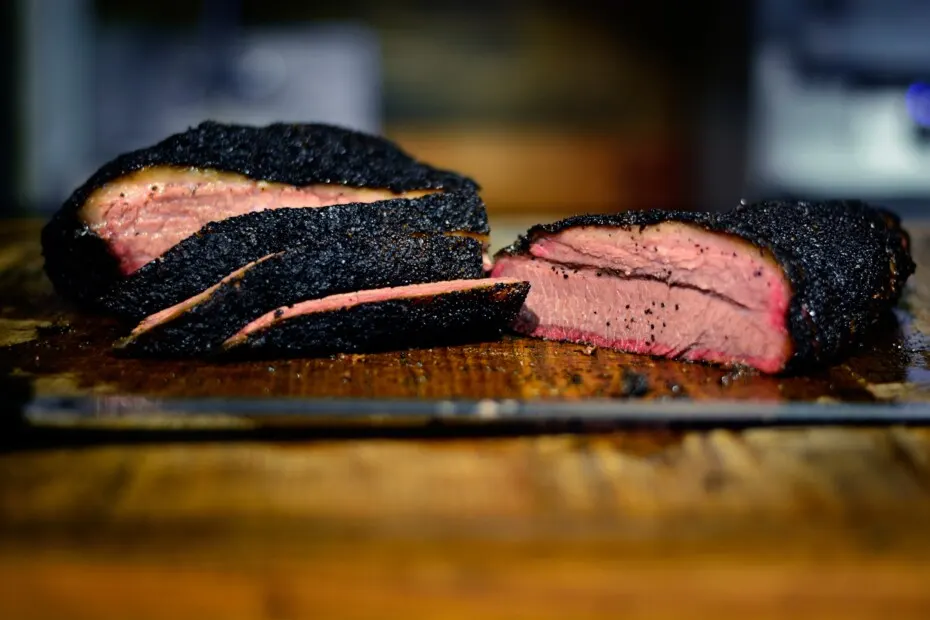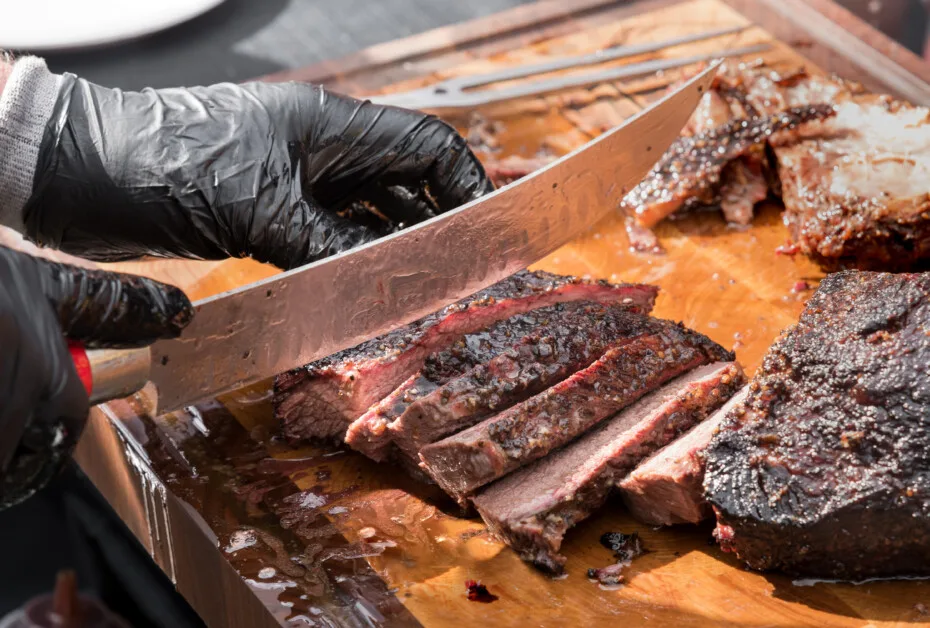Let’s be honest; brisket is a simple cut of meat. However, brisket is an intimidating tough cut of beef that is hard to extremely master. In fact, most cooks opt for easier tender cuts of meat.
However, some of us have learned the tricks of the trade when it comes to cooking brisket.
Though it may seem exhausting, tedious to some, low and slow is the way to cook a brisket. However, once you taste a slice of juicy, tender brisket, it will all seem worth it.
Briskets tend to be way too large to consume in one sitting, especially if you are cooking for a small family.
While you may think the best option is to toss your leftover brisket in the trash, you would only be wasting your money.
Reheating brisket is possible, and it will not lose all of its moisture or transform into dried beef jerky.
When reheated correctly, your brisket will be almost as delicious as it was when it was freshly cooked.
Contents
How To Store Brisket Correctly
Before we get to reheating brisket, we must discuss how to store it. Storing brisket correctly is almost as important as cooking and reheating.
It determines whether you will have a successful or unsuccessful reheating process.
If you intend to store your brisket in the freezer, it may be best to leave it whole instead of cutting it into slices.
Leaving it whole preserves most of the briskets moisture, and it will not be easily exposed to contamination.
Though it may absorb a lot of freezer space, this is definitely the best way to freeze brisket. Additionally, for best results, store your brisket in a vacuum-sealed bag. It will seal in moisture and keep air out.
If you do not have a vacuum sealing machine, you can wrap your brisket tightly with heat-safe plastic wrap and then wrap it with foil. Place it in a freezer, your safe bag, and your brisket will remain fresh and delicious.
If you use this method, pour some of the residual brisket juices onto the meat and allow it to absorb into the meat before you wrap it.
This will give it extra moisture and help it remain fresh until its next use.

How to Reheat Brisket
While brisket may seem hard to reheat, it is very easy. You can use several methods to reheat your meat, all of which have advantages and disadvantages. Here are the most common methods for reheating brisket.
How to Reheat Brisket in the Oven
An oven is an excellent option for reheating brisket. Though it requires a few extra steps to ensure your brisket retains its moisture, it is definitely worth it.
While high temperatures may seem like the obvious choice for reheating brisket, this is not the best option.
Higher temperatures will pull the moisture out of the meat, leaving you with a tough, chewy brisket.
The same way it was cooked is the same way brisket should be reheated. Low and slow temperatures are key to reheating brisket in the oven.
Program your oven to 325°F. Remove the brisket from the refrigerator and set it on a rimmed cookie sheet or baking pan.
Allow your brisket to come to room temperature for approximately 25-30 minutes while your oven heats up.
If you transfer your brisket from the fridge to your oven, you will end up with a hot exterior and a cold interior. Letting the brisket come to room temperature promotes even reheating.
Before you place your brisket into the oven, add any residual juices from when the brisket was first cooked.
Additionally, you can also add a cup of beef or chicken broth or water to the brisket.
Double wrap the brisket with foil. Ensure the brisket has a tight seal and is free of holes. This will trap moisture inside the brisket and allow it to reheat evenly.
Place your brisket into the oven and bake it for one hour. However, if your brisket is cut into slices, only cook it for 20 minutes. Your brisket will be steamy and delicious.
How to Reheat Brisket Using the Slow Cooker
Slow cookers are a convenience every kitchen should have. They are especially convenient for reheating brisket.
Reheating brisket in a slow cooker will take about four hours. The slow cooker method may not be as fast as other reheating methods; it gets the job done perfectly.
Allow your brisket to come to room temperature on your countertop for 20 minutes.
Transfer the brisket to your slow cooker. If your brisket cannot fit into your slow cooker, cut it into thick chunks until it fits into the cooking unit.
Place any residual meat juices into your slow cooker, including those fatty deposits of flavor.
If you did not reserve the meat juices and drippings, use a cup of beef or chicken broth or water. You can also add a cup of barbecue sauce for extra flavor.
Place the lid on your slow cooker and cook the brisket for 3-4 hours on low.
How to Reheat Brisket Sous Vide Style
Essentially sous vide is a cooking technique that gives your brisket a gentle water bath. Best of all, this method is less likely to dry out your meat.
Like slow cooking, reheating brisket sous vide style requires a lot of time. It can take up to 5 hours. However, this should be no issue if you are used to cooking brisket.
Allow your brisket to come to room temperature for 20-30 minutes. Place the brisket into a vacuum-sealed bag.
Fill your sous-vide machine with enough water to submerge the brisket and program it to 150°F.
Allow your brisket to relax in its warm bath until it achieves the same temperature as the water.
Additionally, you can reduce the reheating time by slicing the brisket. I know what you are thinking. However, if you slice your brisket, sous vide cooking will not dry it out.
If you slice your brisket into 1/2-inch slices, it will take 10-15 minutes to heat up. In contrast, if you cut it into 2-inch slices, it will take about 2 hours to reheat.
How to Reheat Brisket by Boiling
Though it sounds a bit strange, this boiling brisket is a good option. Brisket that is tightly sealed in a package reheats well. It is a sped-up version of reheating a brisket via the sous vide method.
Best of all, your brisket will not dry out. The secret is determining the internal temperature of the brisket.
While this seems simple, this is not always the easiest thing to do when boiling brisket. Your brisket must have a temperature of 160°F for it to be considered safe to consume.
Though there are sous vide cooking charts available. They will not have the same water temperature if it is boiling.
How to Reheat Brisket on the Grill
Reheating brisket on the grill or smoker will give you nearly identical results to the oven technique.
However, this will take a longer time than the oven method. Additionally, there are a few factors you must take notice of.
Allow your brisket to come to room temperature for 30 minutes to an hour. Allow your grill to heat to a temperature of 225°F.
Avoid overexposing your brisket to much heat. You may want only to heat up one side of your grill. This will allow you to create direct heat and indirect heat grilling zones.
One side of your grill will be hotter, and the other side will be cooler. Cover your brisket with foil and set it in the indirect grilling zone.
Cook it until it achieves a temperature of 155°F.
Once the brisket comes up to the correct temperature, remove the foil and transfer it to the direct grilling zone.
Cook the brisket for 6-10 minutes until it rises to 160°F to serve.
Furthermore, if you are reheating brisket on a gas grill, program it to medium heat. This will preserve as much moisture as possible.
Can I Reheat Brisket in the Microwave?
Technically you can reheat brisket in the microwave. However, you should never reheat brisket in the microwave.
A microwave is designed to convert water molecules into steam. The microwave will cause all of the moisture to evaporate, leaving you with fry, rubbery, unappealing meat!
Final Thoughts
Brisket gives you a healthy amount of deliciously tender meat, way too much meat to consume in one sitting. For this reason, knowing how to store and reheat it is essential.
Make sure you store your brisket properly. If you do not store cooked brisket properly, it will severely impact the reheating process.
Proper storage will allow you to get the most use out of this incredibly versatile cut of meat.
You might also be interested in:

I have been smoking and grilling meat from an early age and enjoy sharing my knowledge and expertise through the hundreds of articles I have written about BBQ. I hope to make everyone’s BBQ journey that little bit easier.

